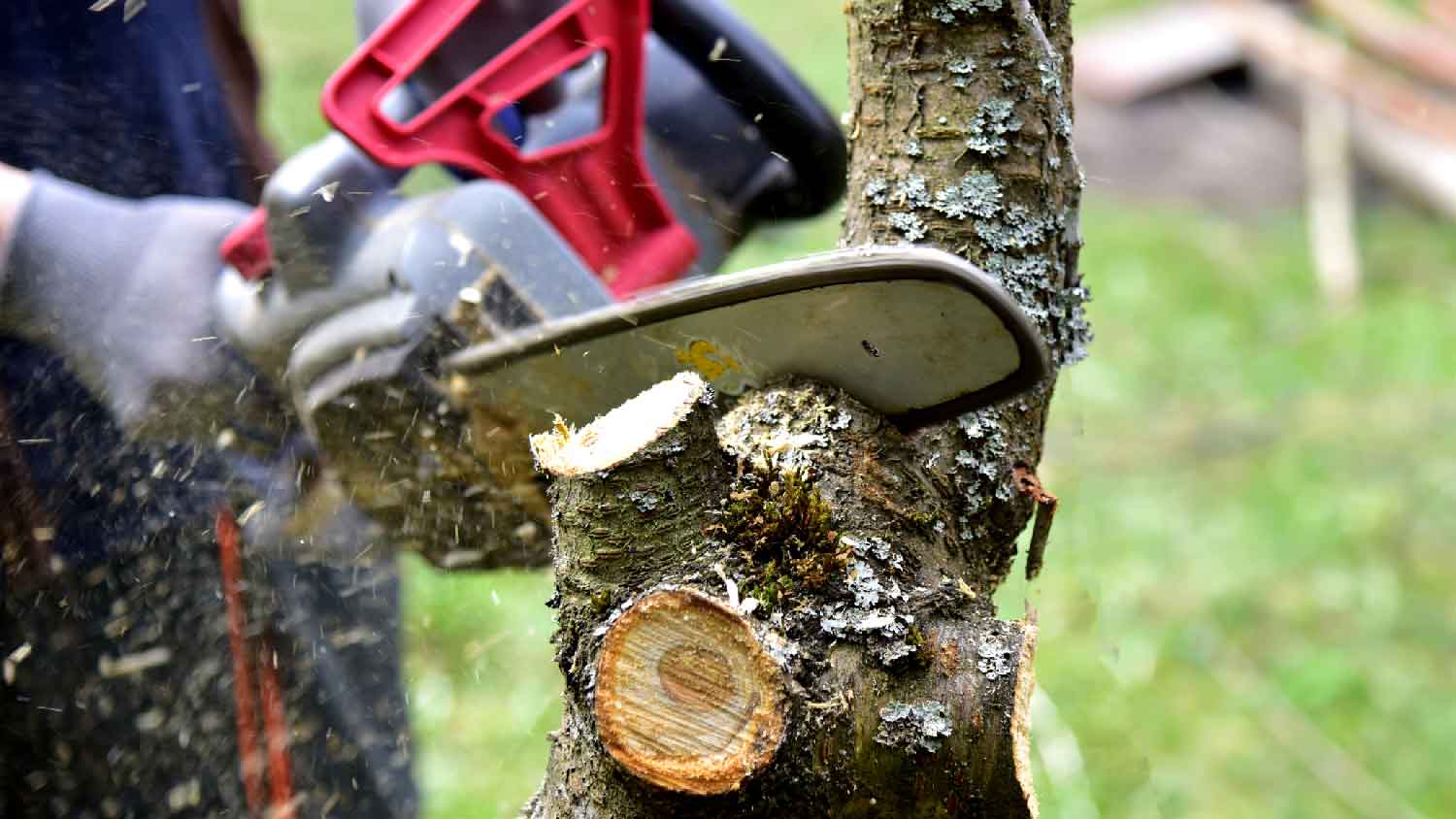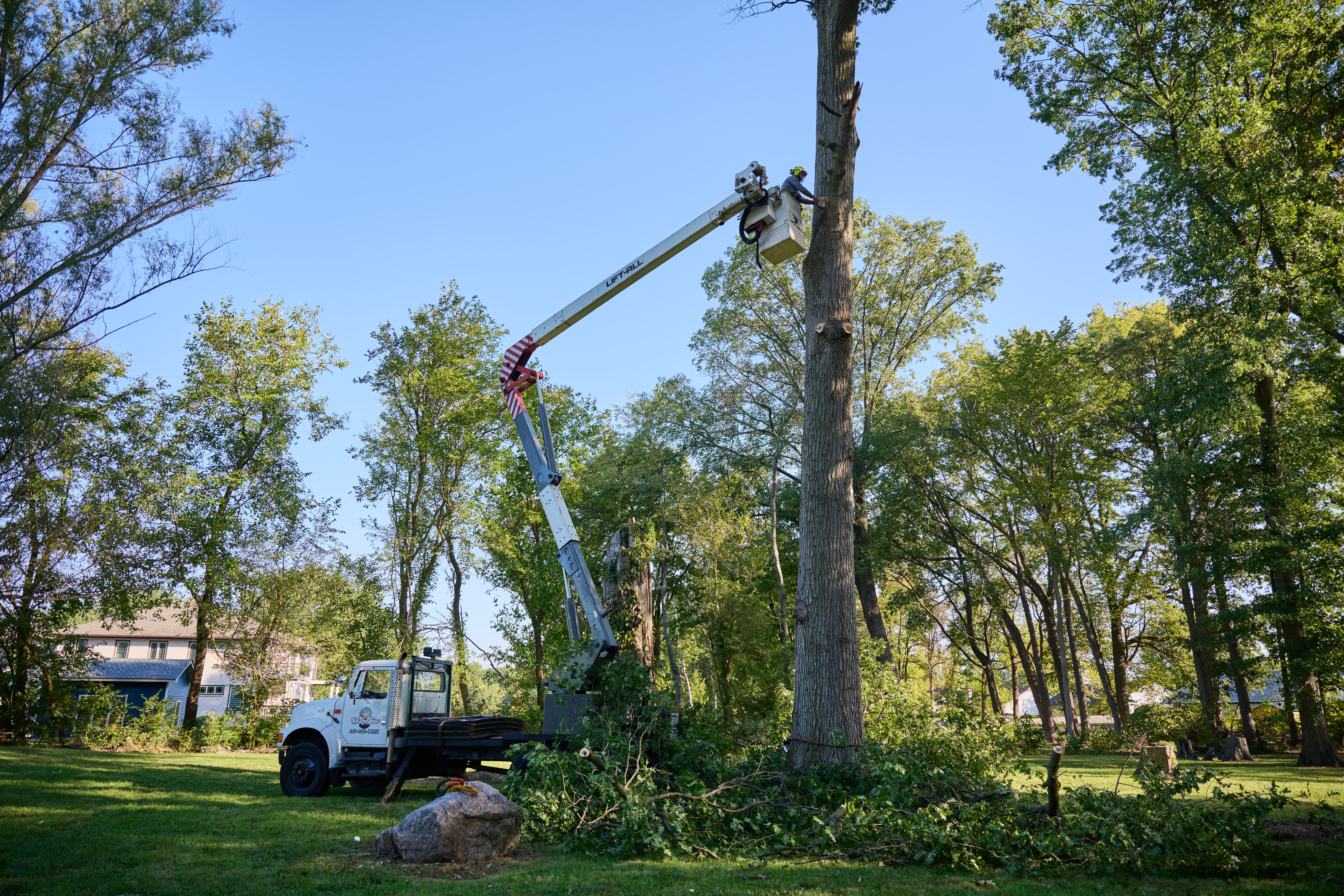
The cost of tree stump removal depends on size, removal method, location, and more. Our guide will show you how much stump removal costs.
It’s possible to save some split trees


After a storm or some serious temperature fluctuations, you might discover a tree that’s split. If you have a tree that’s broken in half, you might ask yourself, “Can it be saved?” The good news is that the answer is often yes. If your tree’s damage is not fatal, and if there is enough of it left healthy, you can likely save your tree. Here’s what you need to know about saving a tree that’s broken in half, whether you decide to tackle your tree emergency yourself or hire a local tree maintenance pro.
If your tree split in half, the first step is to evaluate the damage. If the tree’s main trunk splits all the way to the ground, the damage to the tree is due to disease or infestation, or the tree has lost most of its branches, it’s too late. Trees with this type of damage likely won’t recover and will continue to have issues that can pose safety risks. If that’s the case, it’s best to hire a professional tree removal team to remove the tree from your yard.
If a tree is young and has a partially split trunk, lost one major branch, and is otherwise healthy, you might be able to save it. Younger trees are more well-acclimated to healing damage than older trees because they are already growing out new roots and branches quickly. Calling a local tree maintenance pro to assess the damage and recommend a course of action is a good idea, especially if the tree is tall enough to threaten other trees, structures, or people.
Before starting your project, you must gather some safety gear. Using a saw will be your best bet to cut larger branches, and you should wear a high-quality pair of safety goggles and work gloves while using it. If you’re using a chainsaw, you should use a hard hat, face shield, chainsaw chaps, and some sturdy, steel toed boots. It’s also good to have a rope on hand for tying off branches to help control them as they fall.
You should also prepare for this task by reviewing safety precautions and protocols. Any tree trimming happening near a structure that has large, heavy branches or requires climbing should be done by a tree removal pro to reduce the risk of accident. Before starting pruning work on large branches, you should survey the site and develop a game plan to avoid dropping branches on vehicles, structures, or people.
You can take a few steps immediately to save a damaged tree, and some bigger interventions that require professional help. Here’s what you need to know to save your broken tree.

If dead branches are hanging off the tree, you should prune them away as soon as possible to help stabilize the tree and relieve some of the stress. A tree will continue to try and send nutrients to dead and dying branches, so if a branch is broken and dangling, you should prune it quickly.
Branches should be pruned as close to the tree trunk as possible to allow the bark to heal over the wound. For smaller branches, you can use loppers to prune them, but for larger branches, you can use a power saw to reduce the bulk of the branch and cut a few inches away from the trunk. Then, use a pruning saw to cut close to the trunk to avoid damaging the bark.
Once you’ve rendered first aid steps, you can brace broken limbs. This process should work similarly to casting a broken limb on a person. Like a cast, the bracing gives the tree support while it’s healing. On smaller trees, you may also choose to use tape or burlap wrapping to support injured branches as they heal. Much larger trees might also be repaired by using bolts and cables, but this step is better handled by an experienced arborist due to the tools, equipment, and training necessary for this project.
Choose a pole that's the right height to cradle and support the injured branch.
Use a tree crutch at the top of your pole with as narrow of a rest as possible for the size of your branch.
Secure the pole to the ground, either by driving the base in like a stake or by using sandbags or creating a footing for your tree support.
It’s a good idea to give an injured tree extra water, especially if it’s dry out. Add about two inches of water for a dry tree and one inch of water for a tree that isn’t in drought. To measure an inch of water, you can use a wide shallow container like a pie tin (or several for a larger area) and then use a hose with a watering attachment over the whole area surrounding the roots to slowly water until the tin has the desired water level in it. You can also fertilize an injured tree at a rate of one pound of nitrogen to 1,000 square feet of root volume, but you should wait two years before taking this step.
A damaged tree will need ongoing maintenance after the initial first-aid is performed. Once bracing, wraps, or cabling are in place, you should check your tree regularly for any infestations that could cause damage to the tree. You should also keep an eye on the tree’s growth, monitoring its recovery. Most healthy trees will grow between six and eight inches per season, while a distressed tree will slow down to around two inches a year. If you notice slower growth in the first year or two after an injury, this might be expected after an injury. After that, you may need to consult with a tree care expert to diagnose and address the root cause of the tree’s stunted growth. If your tree stops growing all together, it might be a loss. A tree removal pro or an arborist can also help you figure out this issue.
A little extra watering can also help a tree bounce back from an injury and allow it to heal more quickly. Applying an extra inch of water about once per week if the ground is dry is a good watering pace. Although you might want to help your tree recover, covering wounds in the bark is unnecessary. Cutting away damaged bark and allowing the rest of the bark to heal as the tree grows is all that is needed.
You might be able to save saplings and smaller trees that are broken in half yourself, but for larger trees, it’s necessary to hire a professional tree maintenance specialist near you. Tree care often requires ladder work, large tools, and loose objects high up in the air. In addition, a tree care expert has the training to properly diagnose and address the tree’s problems. Similarly to how you would go to a doctor if you had a major injury, you should utilize the special knowledge tree maintenance specialists have to properly treat your tree’s injury. A reliable assessment of the damage to your tree is also a safety issue if the tree is tall enough to drop limbs on the surrounding area.
From average costs to expert advice, get all the answers you need to get your job done.

The cost of tree stump removal depends on size, removal method, location, and more. Our guide will show you how much stump removal costs.

Tree inspections can ensure your trees stay healthy and safe, preventing costly damage. Learn how much tree inspections cost and what can affect the price.

The most significant factor in tree removal costs is the amount of debris. Read on to learn more about the average tree debris removal costs.

Tree stumps can be unsightly trip hazards, but they can also have a new life. Learn how to hollow out a tree stump to repurpose it into a planter.

Can you cut down a tree on your property? There are laws about trees and chopping them down, so read this guide before you start a tree clearing project.

Tree stumps are more than just unsightly. They can be hazardous, too. Find out why you need to remove a tree stump from the yard and the best time to do it.